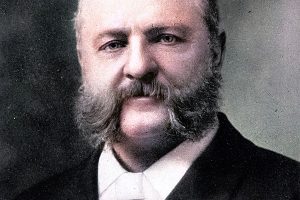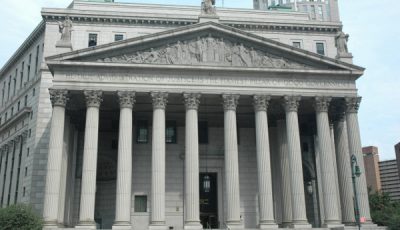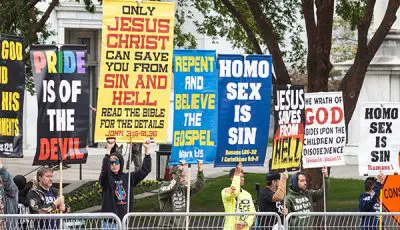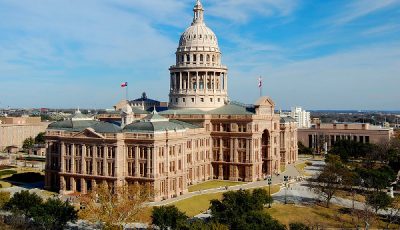The History of Obscenity Laws in the United States (Part 2)
 As promised in last week’s look at The History of Obscenity Laws in the United States (Part 1), we move on now to examine the early history of obscenity laws in America, including early colonial cases, the rise of Anthony Comstock and the Comstock Laws, notable victims of Comstock’s crusade, and censorship of live theater performances and visual arts in America.
As promised in last week’s look at The History of Obscenity Laws in the United States (Part 1), we move on now to examine the early history of obscenity laws in America, including early colonial cases, the rise of Anthony Comstock and the Comstock Laws, notable victims of Comstock’s crusade, and censorship of live theater performances and visual arts in America.
In the early years of American history, societal attitudes towards obscenity were deeply influenced by the religious and moral values of the time — the same force that motivates anti-pornography zealots today. Christian conservatives shaped the foundations of obscenity laws in the United States, which sought to regulate public morality and curb the distribution of materials deemed “offensive” or “indecent.”
Colonial and Early American Attitudes Towards Obscenity
During the colonial period, American society was predominantly influenced by Puritanical beliefs that emphasized strict moral conduct and the suppression of vice. The early settlers brought with them a sense of moral duty to protect the community from what they considered corrupting influences. This led to the establishment of laws aimed at maintaining public decency and punishing those who violated these norms.
In the 17th and 18th centuries, colonial governments in America enacted laws to regulate obscenity, reflecting the prevailing moral and religious values of the time. These laws were often vague and broad, targeting behaviors and materials deemed “lewd” or “lascivious.” The standards for determining what constituted obscenity were largely subjective, relying on contemporary community norms and the discretion of local authorities. The approach was clearly a recipe for the most prudish and restrictive colonists to impose their own visions and opinions on what constitutes a “decent” society.
Early Colonial Cases of Note
One notable example of early obscenity regulation is a 1656 case in the Massachusetts Bay Colony involving William Pynchon, an English colonist and founder of Springfield, Massachusetts. Pynchon authored a religious tract titled “The Meritorious Price of Our Redemption,” which was published in London and later deemed heretical and obscene by the Puritan authorities.
Pynchon’s book was publicly burned in Boston, and this incident is noted as the first book burning in the American colonies. After being summoned to appear before the General Court to answer for his writings, Pynchon instead chose to return to England.
Another significant case involved the prosecution of Thomas Morton, an early settler of the Massachusetts Bay Colony, whose activities at Merrymount (now Quincy, Massachusetts) in the 1620s were seen as lewd and offensive by some in power. Morton erected a maypole and hosted revelries that included dancing, drinking, and other behaviors considered immoral by the Puritan authorities. His actions were deemed a public nuisance and a challenge to the colony’s moral order. Morton was arrested, tried, and ultimately exiled to England, where he continued to criticize the Puritanical rigidity of the colonies.
Colonial Court, Magistrates and Punishments for Obscenity
The process of determining guilt or innocence in early obscenity cases typically involved local magistrates or colonial courts. These authorities would assess the material in question, often consulting community leaders or religious figures to gauge whether it violated the accepted standards of “decency.” The criteria for lewdness or obscenity were not codified, making judgments highly subjective and variable from one colony to another.
Corporal punishment was a common method of enforcing obscenity laws during this time. For instance, individuals found guilty of producing or distributing obscene materials could be subjected to whipping, a practice intended to publicly shame and deter others from similar conduct. Whippings were carried out using a whip or a cat-o’-nine-tails, often in public spaces such as town squares to maximize the humiliation and serve as a stark warning to the community of their government’s intolerance.
In addition to corporal punishment, fines and imprisonment were also used to penalize those found guilty of obscenity. The fines varied depending on the severity of the offense and the discretion of the magistrates. Imprisonment could range from short-term confinement to longer sentences, during which offenders might be subjected to hard labor.
In the Name of Morality
The supposed goal of these laws and punishments was to safeguard the “moral fabric” of the community and uphold a collective sense of propriety. Colonial authorities claimed to believe that maintaining strict “moral standards” (according to their own subjective ideas on morality) was essential for the well-being and stability of their societies — or at least that’s the justification they used to defend their cruel intolerance. This emphasis on public morality reflected the deeply ingrained religious teachings of the time, which viewed any deviation from accepted norms as a threat to the social order.
As a result, the early American colonies established a legal framework for regulating obscenity that would influence the development of obscenity laws in the United States for centuries to come. The combination of vague legal standards, subjective enforcement, and harsh punishments underscored the colonies’ commitment to maintaining what they claimed was “moral discipline and order” in their burgeoning communities.
The Rise and Reign of Anthony Comstock
As the United States emerged and progressed into the 19th century, the legal framework surrounding obscenity became more formalized. One of the most significant developments in this period was the enactment of the Comstock Laws in 1873. Named after Anthony Comstock, a zealous moral crusader and the founder of the New York Society for the Suppression of Vice, these laws represented a major effort to combat the dissemination of obscene materials.
Anthony Comstock was a devout Christian (surprise!) and a member of the Congregational Church. His religious beliefs were central to his worldview (surprise!), and he justified his fight against obscenity as a moral and religious duty. He believed that exposure to obscene materials led to moral decay and sinful behavior, and he supposedly felt compelled to “protect” individuals, especially the young, from such influences. (Editor Translation: “Won’t somebody think of the children!”)
Comstock had grow up in a devoutly religious household in Connecticut, a foundation that strongly influenced his moral outlook. The death of his younger brother while serving in the Union Army during the Civil War deeply affected him. Comstock himself served in the war, and his exposure to the rough and often morally lax behavior of soldiers reinforced his belief in the need for strict moral discipline. Apparently the soldiers were having too much fun for Comstock’s liking.
His fervor for imposing his own views of morality gained the attention and support of influential figures, including politicians and business leaders. His lobbying efforts culminated in the passage of the Comstock Laws in 1873, which gave him significant power to enforce anti-obscenity measures. He was appointed as a special agent of the U.S. Post Office, allowing him to inspect and confiscate obscene materials sent through the mail. As we’ll discuss in later articles, this power has since been used by subsequent agents of the U.S. Post Office, all the way up to modern times.
Comstock’s methods included undercover operations, sting operations, and public prosecutions. He confiscated and destroyed vast amounts of material deemed obscene. Over his career, Comstock claimed to have seized 160 tons of obscene literature and 4 million pictures.
The Comstock Laws
The Comstock Laws, formally known as the Act for the Suppression of Trade in, and Circulation of, Obscene Literature and Articles of Immoral Use, were a set of federal statutes enacted by the United States Congress on March 3, 1873. These laws were aimed at curbing the distribution of materials deemed obscene and had broad and sweeping provisions, which had significant and lasting impacts on American society and culture.
Prohibited Materials: The Comstock Laws were comprehensive in their prohibition of various forms of content and items. Specifically, the laws made it illegal to mail the following:
- Obscene, Lewd, or Lascivious Literature: This included any printed material, such as books, pamphlets, magazines, and newspapers, that were deemed offensive by contemporary moral standards. The criteria for what constituted obscenity were vague, allowing for broad interpretation.
- Advertisements: Advertisements for any type of obscene material, as well as for products related to birth control or sexual health, were banned. This affected the dissemination of information about contraceptive devices and methods.
- Contraceptive Information and Devices: One of the most contentious aspects of the Comstock Laws was their prohibition on mailing contraceptive information and devices. This included not only birth control devices such as condoms and diaphragms but also any literature that provided information on family planning and sexual health.
Victims of Anthony Comstock
Comstock’s relentless pursuit of moral purity led to the confiscation and destruction of thousands of publications and the arrest of numerous individuals. Two of the more notable cases involved women’s rights activist Margaret Sanger and social reformer Ezra Heywood.
Margaret Sanger
Margaret Sanger, born in 1879, emerged as one of the most influential figures in the birth control movement in the early 20th century. Her activism was largely shaped by her experiences as a nurse in New York City, where she witnessed the dire consequences of unwanted pregnancies and unsafe abortions. Motivated by the plight of women who lacked access to reliable contraception, Sanger embarked on a mission to educate women about reproductive health and to advocate for the legalization and widespread availability of birth control.
In 1914, Sanger launched a monthly newsletter called “The Woman Rebel.” This publication was radical and progressive for its time, as it openly discussed topics such as contraception, women’s rights, and sexual health. The motto of the newsletter was “No Gods, No Masters,” reflecting Sanger’s belief in women’s autonomy over their own bodies, a fight that goes on to this day.
The content of “The Woman Rebel” directly challenged the Comstock Laws, which prohibited the dissemination of “obscene” materials through the mail, including information about contraception. As a result, the publication quickly drew the attention of Anthony Comstock and the federal authorities he commanded. “The Woman Rebel” was deemed to be obscene, and subsequently banned in America. The banning of “The Woman Rebel” did not deter Sanger; instead, it fueled her determination to fight for women’s reproductive rights. She continued to publish and distribute information on contraception through other means, often using underground networks and supportive allies to circumvent the legal restrictions.
In August 1914, Sanger was indicted on multiple counts for violating the Comstock Laws by sending “obscene” materials through the mail. Facing the possibility of up to 45 years in prison, she fled to Europe to avoid prosecution. During her time abroad, she continued to study and advocate for birth control, gaining further knowledge and support from European activists and doctors. America had for the time lost one of its forward thinkers who had dedicated her life to helping women avoid hardships and misery, and all in the name of battling “obscenity.”
Sanger only returned to the United States in 1915 after her husband, William Sanger, was arrested for distributing one of her pamphlets, “Family Limitation.” William’s trial garnered significant public attention and sympathy for the birth control cause, leading to increased support for Margaret’s work.
Despite public support, Sanger continued to face legal challenges. In 1916, she opened the first birth control clinic in the United States in Brownsville, Brooklyn. Nine days after its opening, the clinic was raided by police, and Sanger was arrested and jailed for 30 days for distributing contraceptive information.
In 1921, Sanger founded the American Birth Control League, which later became known as Planned Parenthood. This organization played a crucial role in advocating for reproductive rights, providing contraceptive services, and educating the public about sexual health. Sanger’s relentless activism and the organizations she established laid the groundwork for significant legal and social changes regarding reproductive health in the United States. Her efforts eventually contributed to the landmark Supreme Court decision in Griswold v. Connecticut (1965), which recognized the constitutional right of married couples to use contraceptives.
Margaret Sanger’s life and work were deeply intertwined with the challenges posed by the Comstock Laws. Her defiance of these restrictive statutes and her tireless efforts to promote reproductive health and education left a lasting legacy that continues to influence the fight for women’s rights and bodily autonomy today.
Ezra Heywood
The Impact of Early Censorship on Literature and Media
The stringent enforcement of obscenity laws in the 19th century had a profound impact on literature and media in the United States. Authors, publishers, and artists faced significant risks in producing and distributing works that could be deemed obscene. The fear of prosecution and censorship stifled creativity and limited the dissemination of ideas that challenged conventional moral standards.
Despite these challenges, some works managed to navigate the restrictive legal landscape and achieve lasting influence. For instance, Walt Whitman’s “Leaves of Grass,” first published in 1855, faced criticism and censorship due to its explicit content and celebration of the human body. However, Whitman’s work ultimately gained recognition for its literary merit and contributed to the evolving conversation about artistic freedom and expression.
In the 17th and 18th centuries, early American censorship efforts were not limited to written works; they also extended to theatrical performances and visual arts. Authorities and community leaders scrutinized plays and art exhibitions, often shutting down or heavily editing those deemed obscene. This period of censorship set the stage for the ongoing debate between protecting public morality and preserving artistic and intellectual freedom.
Theatrical Performances
Theatrical performances in the American colonies were often subject to scrutiny by local authorities, who viewed the theater as a potential source of moral corruption. In Puritan New England, theater was particularly frowned upon, with some colonies enacting outright bans on theatrical performances. For instance, the Massachusetts Bay Colony passed a law in 1750 prohibiting stage plays and other forms of entertainment deemed “disruptive to public morality.”
Even in colonies where theater was more accepted, performances that included sexual content, profanity, or politically sensitive material were at risk of censorship. Theater companies often had to submit their scripts to local censors for approval before they could be performed. Plays that were considered lewd or offensive were either edited to remove the objectionable content or banned altogether.
John Gay’s “The Beggar’s Opera,” a satirical play first performed in London in 1728, faced censorship issues when it was brought to the American colonies. The play’s critique of political corruption and its portrayal of criminality and vice led to concerns among colonial authorities, resulting in pressure to alter the script for American audiences.
Oliver Goldsmith’s comedy “She Stoops to Conquer” also faced scrutiny. While not banned outright, performances in some colonies were closely monitored to ensure that the content did not violate local standards of “decency.
Visual Arts
Visual art in early America was often influenced by European traditions and religious themes. Artists had to navigate a fine line between creative expression and the prevailing moral standards of their communities. Art exhibitions, particularly those featuring nudes or provocative subjects, were subject to censorship.
One early example is the case of John Singleton Copley, an American painter known for his portraits. Copley’s works, which occasionally included classical nudes, faced criticism and calls for censorship from conservative quarters. While Copley managed to maintain his reputation and continue his work, the controversy surrounding his art underscored the challenges faced by artists during this period.
Many artists preemptively toned down their work to avoid conflict with authorities and public backlash. This self-censorship stifled artistic innovation and limited the range of subjects that could be explored in visual art.
Works that were deemed too provocative were often altered or hidden from public view. For instance, sculptures and paintings featuring nudity or mythological themes were sometimes modified to add clothing or alter poses to conform to societal expectations.
Legacy and Ongoing Debate
The early censorship of theater and visual arts established legal precedents and societal norms that would influence future debates on artistic freedom. These early efforts to regulate content based on moral standards laid the groundwork for more structured and formalized censorship mechanisms in the 19th and 20th centuries. The tension between “protecting public morality” and preserving artistic and intellectual freedom continued to evolve, reflecting broader societal changes. As America grew and diversified, so did the perspectives on what constituted acceptable art and performance.
By the 19th century, the American theater saw increased censorship, particularly during the Victorian era, when moral standards became more stringent. Notable examples include the banning of “Mrs. Warren’s Profession” by George Bernard Shaw and the editing of Shakespearean plays to remove perceived indecencies.
In the visual arts, controversies continued well into the modern era, with artists like Thomas Eakins and later, in the 20th century, Robert Mapplethorpe, facing censorship for their provocative and boundary-pushing works.
Next entry we’ll take a look at birth of modern obscenity standards, including the development of the “Hicklin Test,” plus major case developments like Ross v. United States (1957) and Miller v. California (1973).















